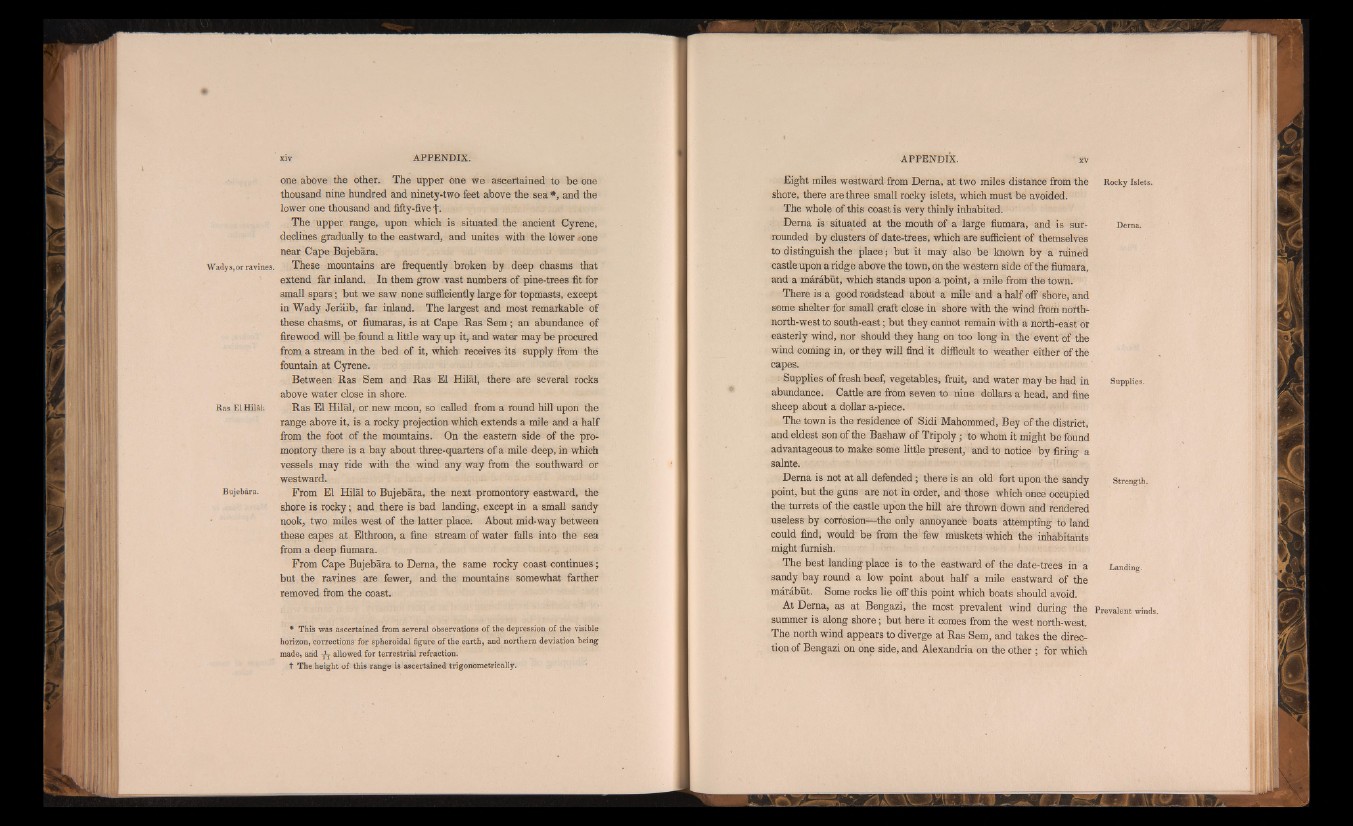
Wadys, or ravines.
one above the other. T h e upper one we ascertained to be one
thousand nine hundred and ninety-two feet above the se a *, and the
lower one thousand and fifty-five j \
The upper range, upon which is situated the ancient Gyrene,
declines gradually to the eastward, and unites with the lower ¿one
near Cape Bujebara.
These mountains are frequently broken by deep chasms that
extend far inland. In them grow vast numbers of pine-trees fit for
small spars:; b u t we saw none sufficiently large for topmasts, except
in Wady Je ra ib , far inland. The largest and most remarkable of
these chasms, or fiumaras, is a t Cape Ra s Sem ; an abundance of
firewood will be found a little way up it, and water may be procured
from a stream in the b ed of it, which receives its supply from the
fountain at Cyrene.
Between Ra s Sem and Ra s El Hilal, there are several rocks
above water close in shore.
Has El Hilal: Ra s El Hilal, or new moon, so called from a round hill upon the
range above it, is a rocky projection which extends a mile and a half
from the foot o f the mountains. On the eastern side of the promontory
there is a bay about three-quarters of a mile deep, in which
vessels may ride with the wind any way from the southward or
westward.
Bujebara. From El Hilal to Bujebara, the next promontory eastward, the
shore is rocky; and there is bad landing, except in a small sandy
nook, two miles west of the latte r place. About mid-way between
these capes a t Elthroon, a fine stream of water falls into the sea
from a deep fiumara.
From Cape Bujebara to Dema, the same rocky coast continues;
but the ravines are fewer, and the mountains somewhat farther
removed from the coast.
* This was ascertained from several observations of the depression of the visible
horizon, corrections' for spheroidal figure of the earth, and northern deviation being
made, and allowed for terrestrial refraction.
t The height o f this range is ascertained trigonometrically.
Eight miles westward from Dema, a t two miles distance from the
shore, there are three small rocky islets, which m ust be avoided.
The whole of this coast is very thinly inhabited.
Dema is situated a t the mouth of a large fiumara, and is surrounded
by clusters of date-trees, which are sufficient of themselves
to distinguish the p la c e ; but it may also be known by a ruined
castle upon a ridge above the town, on the western side of the fiutnara,
and a marabut, which stands upon a point, a mile frofii the town.
There is a good roadstead about a mile and a half off Shore, and
some shelter for small craft d o se in shore with the wind froth north-
north-west to south-east; but they cannot remain with a north-east or
easterly wind, nor should they hang on too long in the event of the
wind coming in, or they will find it difficult to weather either of the
capes.
Supplies of fresh beef, vegetables, fruit, and water may be had in
abundance. Cattle are from seven to nine dollars a head, and fine
sheep about a dollar a-piece.
The town is the residence of Sidi Mahommed, Bey of the district,
and eldest son of the Bashaw of T rip o ly ; to whom it might b e found
advantageous to make some little present, and to notice b y firing a
salnte.
D ema is not a t all defended; there is an old fort upon the sandy
point, b u t the guns are not in order, and those which once occupied
the turrets of the castle upon the hill are thrown down and rendered
useless by corrosion-—the only annoyance boats attempting to land
could find, would be from the few mUskets which the inhabitants
might furnish.
T he b e s t landing place is to the eastward of the date-trees in a
sandy bay round a low point about half a mile eastward of the
marabut. Some rocks lie off this point which boats should avoid.
At Dema, as at Bengazi, the most prevalent wind during the
summer is along sho re ; but here it comes from the west north-west.
The north wind appears to diverge at Ras Sem, and takes the direction
of Bengazi on one side, and Alexandria on the o th e r ; for which
Rocky Islets.
Derna.
Supplies.
Strength.
Landing.
Prevalent winds.